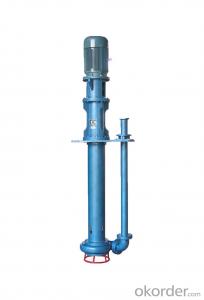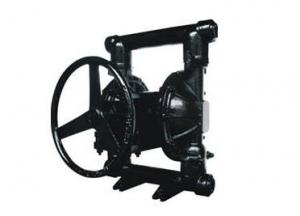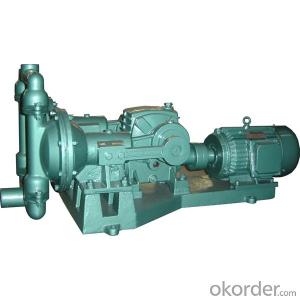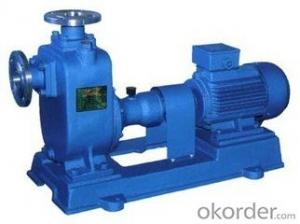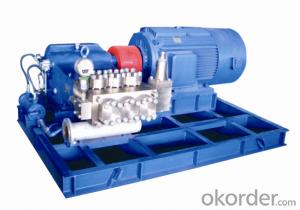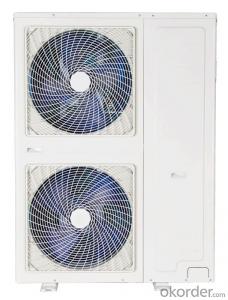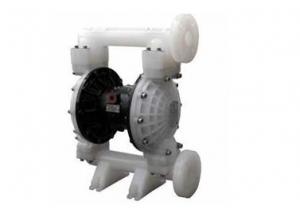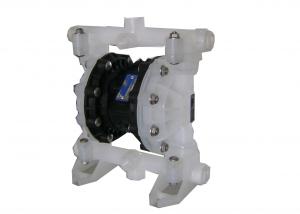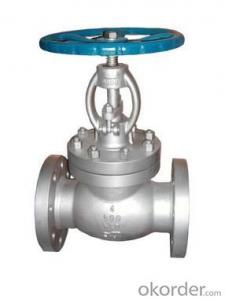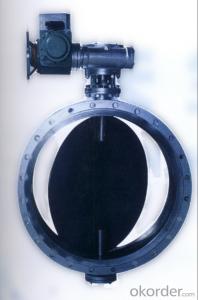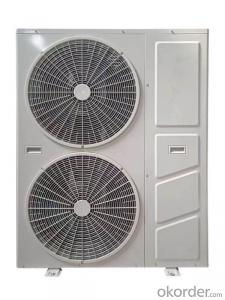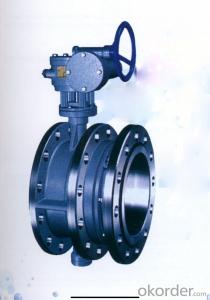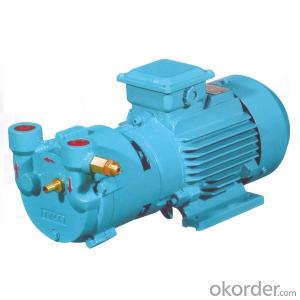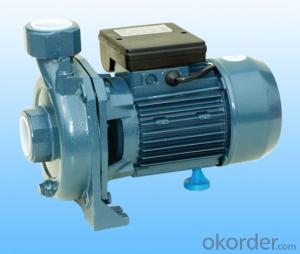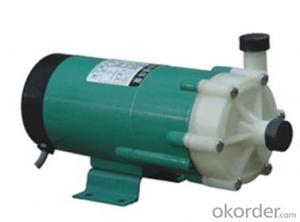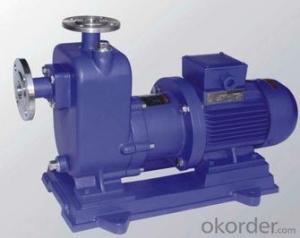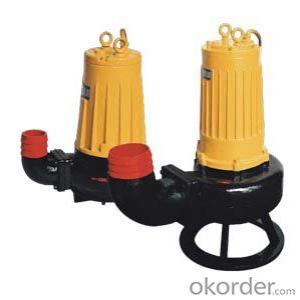YZ Submersible Slurry Pump
- Loading Port:
- China Main Port
- Payment Terms:
- TT OR LC
- Min Order Qty:
- -
- Supply Capability:
- -
OKorder Service Pledge
OKorder Financial Service
You Might Also Like
1 ,Feature :
YZ Series Slurry Pump is single stage ,single Suction (Suspension-Type ) pump ,it is connect with water power parts by bear seat ,supporting seat connecting tube .Liquid is exhaust out by Exhaust Pipeline component,Impeller of pump is designed semi-opened,Assigned an mixing blade ( propeller) in impeller blade extending .The mainly characteristic is pump shaft under liquid have enough stiffness , it is doesn't install bear between impeller and pump cover , it doesn't take bear seal,
so this pump can transmit Higher concentration rigid granules (particles) mediums.
This pump can input liquid on depth 800-2000mm
We can install an suction tube If you need . Shaft seal is running by submersible Pump insert into liquid , No Bear Seal , Transmit device by Motor installed Motor supporting and undertaking Seat , connecting with pump by coupling .
2 ,Application Field:
This series Pump widely application on environmental protection ,Municipal Engineering,Thermal power plant,Gas coking plant,Refinery plant ,Steelmaking plant,Mining ,Paper industry,The cement factory,food factory, printing and
dyeing industry to extract Dope ,heavy oil, Oil residue,Dirty liquid, mud, Mortar,The flow sand and urban sewage floating sludges , contained coal or ash in liquid. It is also can be used as chemical, pharmaceutical and other
industries suction fluid containing sand slag material and corrosive liquids. YZ can also transfer heat Temperature (480 degree ) of kerosene, crude oil, asphalt, oil Residue and other working conditions.
3,Model Sense :
Model No :80YZ80-20A
YZ-Submersible Slurry Pump
80-Outlet Diameter :(mm)
80-Pump Designed Flow :(m3/h)
20-Pump Designed Head :(m)
A- Impeller dissection by one time
- Q:Can an air pump be used for inflating air toys?
- Yes, an air pump can be used to inflate air toys.
- Q:Can an air pump be used for inflating air loungers?
- Indeed, air loungers can be inflated using an air pump, which is often the most convenient and efficient method. The purpose of air pumps is to swiftly and effortlessly fill inflatable items, including air loungers, with air. They are equipped with various nozzle attachments to accommodate different valve sizes, allowing for easy connection to the air lounger's valve. Furthermore, air pumps supply the necessary air pressure to fully inflate the air lounger, guaranteeing a comfortable and supportive seating or lounging experience. To avoid any leakage or harm to the inflatable, it is crucial to ensure that the air pump is compatible with the air lounger's valve.
- Q:BMW 740 after the air pump and air pump relay installation position
- The old section is the spare tire, the air pump and the relay are one. The new one is carried on the back.
- Q:Are there any specific safety features to prevent overheating in an air pump?
- Yes, there are specific safety features in air pumps to prevent overheating. One common safety feature is a built-in thermal protection switch. This switch monitors the temperature of the air pump and automatically shuts it off if it exceeds a certain temperature threshold. This prevents the pump from overheating and potentially causing damage or starting a fire. Additionally, air pumps often have built-in cooling mechanisms such as fans or heat sinks to dissipate heat and keep the internal components at a safe operating temperature. These cooling mechanisms help prevent overheating by promoting airflow and heat transfer away from the pump. Some high-end air pumps also come with temperature sensors that constantly monitor the internal temperature and adjust the pump's operation accordingly. For example, if the temperature starts to rise, the pump may slow down or reduce its output to prevent overheating. It's important to note that even with these safety features, it is still essential to use the air pump responsibly and avoid blocking the airflow or operating it in extremely hot environments. Regular maintenance and cleaning of the pump can also help prevent overheating by ensuring that dust or debris does not clog the cooling mechanisms.
- Q:Can an air pump be used for inflating air-filled promotional products?
- Yes, an air pump can be used for inflating air-filled promotional products. Air pumps are designed to provide a quick and efficient method of inflating various objects, including inflatable promotional products such as balloons, inflatable furniture, and other air-filled items. By connecting the pump to the promotional product's valve, one can easily inflate it to the desired level of firmness. This method is often preferred over manual inflation as it saves time and effort, ensuring a consistent result. Additionally, air pumps usually come with different nozzle attachments to fit various valve sizes, making them versatile for inflating different types of air-filled promotional products.
- Q:How does an air pump increase oxygen levels in water?
- Water oxygen levels are increased by an air pump, which carries out aeration by introducing air or oxygen into the water. The air pump draws in atmospheric air and forces it into the water through a small tube or hose. As the air bubbles ascend to the water's surface, they release oxygen and create turbulence, effectively distributing the oxygen throughout the water column. This process is vital for sustaining the health of aquatic ecosystems, particularly in bodies of water with limited oxygen, like aquariums, ponds, or fish tanks. By boosting the oxygen concentration in the water, an air pump aids in the respiration of aquatic organisms, including fish, plants, and bacteria. Insufficient oxygen levels can lead to stress, disease susceptibility, and even suffocation in fish and other aquatic animals. Additionally, low oxygen levels can facilitate the growth of harmful bacteria or algae, posing further harm to the aquatic ecosystem. An air pump also contributes to water quality by facilitating aerobic decomposition, which breaks down organic matter. This process relies on oxygen to decompose organic waste, preventing the accumulation of harmful substances and unpleasant odors in the water. In summary, the introduction of oxygen into the water through an air pump is critical to maintaining a healthy aquatic environment and ensuring the well-being of aquatic organisms.
- Q:What safety precautions should be taken while using an air pump?
- When using an air pump, there are several safety precautions that should be taken to ensure your well-being: 1. Read the instruction manual: Before using an air pump, carefully read the manufacturer's instruction manual. This will provide you with important information regarding safe operation, maintenance, and any specific precautions you should be aware of. 2. Wear protective gear: It is advisable to wear safety goggles or glasses to protect your eyes from any potential flying debris or accidental release of air. Additionally, using gloves can prevent injury while handling the pump or any sharp objects that may be involved. 3. Check for damage: Before using an air pump, inspect it for any visible damage such as cracks, cuts, or worn-out parts. Using a damaged pump can be dangerous and may lead to accidents or injuries. 4. Use in a well-ventilated area: Ensure that you use the air pump in a well-ventilated space to prevent the accumulation of harmful fumes or gases. This is particularly important if you are using a pump that runs on fuel or if you are inflating objects that release gases during the process. 5. Keep children and pets away: Air pumps can be noisy and may have moving parts that can cause harm. It is essential to keep children and pets at a safe distance to avoid accidents or injuries. 6. Use the correct power source: Depending on the type of air pump, it may require electricity, batteries, or fuel. Always use the appropriate power source as stated in the instruction manual. Using the wrong power source can damage the pump, cause malfunctions, or even result in electrical or fire hazards. 7. Pay attention to pressure limits: Air pumps typically have pressure limits that must not be exceeded. Overinflating objects can lead to bursting or explosions, causing serious injuries. Always check the recommended pressure for the item you are inflating and monitor the pressure gauge on the pump to ensure you do not exceed the limit. 8. Store properly: When not in use, store the air pump in a dry and secure place, away from extreme temperatures or direct sunlight. This will help maintain the pump's performance and prevent any potential accidents. By following these safety precautions, you can minimize the risks associated with using an air pump and ensure a safe and enjoyable experience.
- Q:What is the noise level produced by an air pump during operation?
- The noise level that an air pump produces while in operation can vary depending on several factors. These factors include the type and quality of the air pump, the speed at which it operates, and the surrounding environment. Typically, air pumps generate a moderate level of noise, ranging from 40 to 70 decibels (dB). Smaller and more efficient air pumps tend to create less noise, whereas larger and more powerful ones may produce higher levels of noise. Additionally, the speed at which the air pump operates can impact the noise level, with higher speeds generally resulting in louder noise. It is worth noting that the noise level of an air pump can also be influenced by the environment in which it is used. If the air pump is placed in a closed or small space, the noise can be amplified due to the reverberation effect. Conversely, if the air pump is utilized in an open or well-ventilated area, the noise may be less noticeable. To minimize noise, there are certain measures that can be implemented. The use of an air pump with noise-reducing features, such as rubber feet or vibration dampening materials, can help decrease noise levels. Additionally, placing the air pump on a stable surface or utilizing soundproofing materials in the surrounding area can also reduce noise. In conclusion, although air pumps do generate some level of noise during operation, it is generally manageable and can be mitigated through the use of appropriate equipment and placement.
- Q:How does an air pump handle different airflow capacities?
- Various airflow capacities can be handled by an air pump through the adjustment of its speed and power output. The pump possesses a controllable motor capable of increasing or decreasing its speed, thereby generating varying air pressure and flow rates based on the desired capacity. Furthermore, adjustable valves or nozzles are frequently included with air pumps, which aid in regulating airflow by either restricting or enlarging the opening size. These characteristics grant the air pump the ability to accommodate diverse airflow capacities and deliver the necessary amount of air for a multitude of applications.
- Q:Can an air pump be used for inflating life vests?
- Certainly, life vests can be inflated using an air pump. In fact, it is highly recommended as the optimal approach to guarantee proper inflation and readiness for use. By employing an air pump, a regulated and consistent stream of air is delivered, facilitating the inflation process of life vests to their required buoyancy and safety levels. Moreover, the utilization of an air pump minimizes the likelihood of over-inflation, which has the potential to harm the life vests. Therefore, it is essential to employ a pump that is compatible with the valve mechanism on the life vests, ensuring a secure and efficient inflation procedure.
1. Manufacturer Overview |
|
|---|---|
| Location | |
| Year Established | |
| Annual Output Value | |
| Main Markets | |
| Company Certifications | |
2. Manufacturer Certificates |
|
|---|---|
| a) Certification Name | |
| Range | |
| Reference | |
| Validity Period | |
3. Manufacturer Capability |
|
|---|---|
| a)Trade Capacity | |
| Nearest Port | |
| Export Percentage | |
| No.of Employees in Trade Department | |
| Language Spoken: | |
| b)Factory Information | |
| Factory Size: | |
| No. of Production Lines | |
| Contract Manufacturing | |
| Product Price Range | |
Send your message to us
YZ Submersible Slurry Pump
- Loading Port:
- China Main Port
- Payment Terms:
- TT OR LC
- Min Order Qty:
- -
- Supply Capability:
- -
OKorder Service Pledge
OKorder Financial Service
Similar products
New products
Hot products
Related keywords
